Warthog Profile
Warthogs have a typical pig-like appearance and come from the same family as domestic pigs, wild boars and babirusa.
They have large, fairly flat faces containing wart like structures just above the snout, which is where their name is derived from. They have two sets of warts and these are a lot bigger and more pronounced in males.
Warthogs also have tusks which develop from their canine teeth and protrude above the upper lip. At times warthogs can appear quite ferocious. They use this tactic well, however they are mainly grazers and primarily eat only grasses and roots.

Warthog Facts Overview
| Habitat: | Savannah areas |
| Location: | Africa |
| Lifespan: | Approximately 17 years in captivity (lifespan probably less in the wild) |
| Size: | 60-80 cm in height and 1.3-1.8m in length |
| Weight: | 60-105 kg (Males) 45-70 kg (Females) |
| Color: | Grey skin with scattered bristles, a dark mane of coarse hair that extends from the head along the spine |
| Diet: | Omnivorous – Grass in the wet season and roots and bulbs in the drier seasons, but can eat insects, eggs and carrion |
| Predators: | Lions, leopards, cheetahs, crocodiles, hyenas |
| Top Speed: | 40-55 kph (25-35 mph) |
| No. of Species: |
2 |
| Conservation Status: |
Least concern |
There are two species of warthog, the desert warthog and the most well known and widespread, common warthog. Desert warthogs can be differentiated from the common species by their curled ear tips, larger snout and lack of front teeth.
The warthog is the only pig that is adapted to live and graze in savannah type habitats. They like more open areas and do not generally inhabit forests, rainforests and areas of dense undergrowth.
Although they like more dry surroundings, warthogs wallow in muddy water daily. This can often result in their skin taking on the colour of the mud they bathe in. They do this to help cool down on hot days.
Because savannah areas can get fairly cool at night, and warthogs do not have a lot of hair to keep them warm, they like to find burrows or holes to help keep them warm. They often utilise aardvark or porcupine holes and modify them for their own purpose.
In places where there are more defined seasons, warthogs will breed and give birth at the beginning of the rains. Where the seasons are more interchangeable, there is no strict time for females to give birth. The average litter size is 2-3 piglets, with adults being able to reproduce at approximately 1.5 years old.
When food is plentiful in the rainy seasons, warthogs will graze. However when food is in shorter supply during the drier seasons, they will eat roots and tubers that are found underground. They use their strong sense of smell to help locate these food sources and their tough snouts to help dig them up.
You will often find warthogs eating while kneeling on their front legs and they can use this position to help shuffle around on the ground also. They have feeding peaks during the early hours of the day or later in the afternoon. At times when they know humans are around they will adapt their behaviour and eat during the night.
The top predators of warthogs are lions, leopards and cheetahs. Hyenas and painted dogs will also predate upon them, however as warthogs have slightly longer legs than other types of pig, they can run quickly and often outmanoeuvre their opponent.
Interesting Warthog Facts
1) Warthog have two pairs of tusks
Their tusks are actually teeth, that protrude from the mouth and curve upwards. The upper canine teeth can grow up to 10 inches in length, while the lower teeth are shorter, but razor sharp and capable of inflicting serious damage.
While warthog usually run from danger, they do use them in combat against other hogs, as well as predators. 1
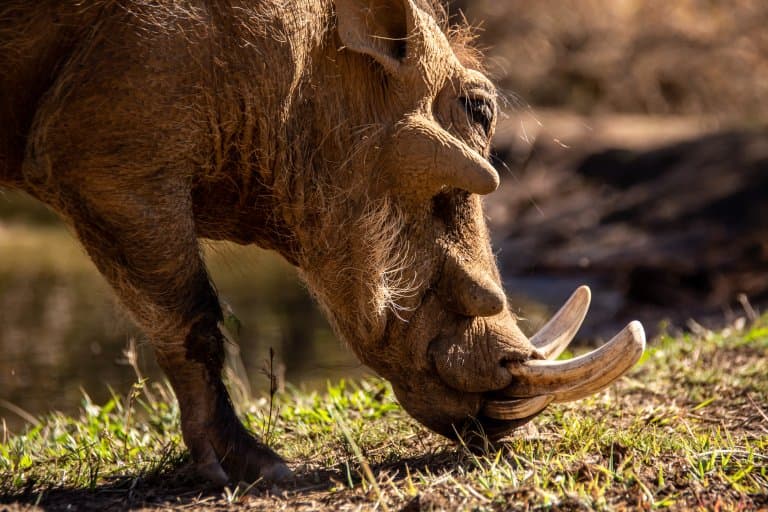
2) They trot with their tails up
When a warthog walks, its tail hangs down but when they start to trot or run their tail shoots upright like an antenna.
People are not sure if this is a warning signal as the tail appears to automatically do this when they run anyway.
3) They can run up to 55 kph (35 mph)
This is often to escape predators and to hide in their burrow.
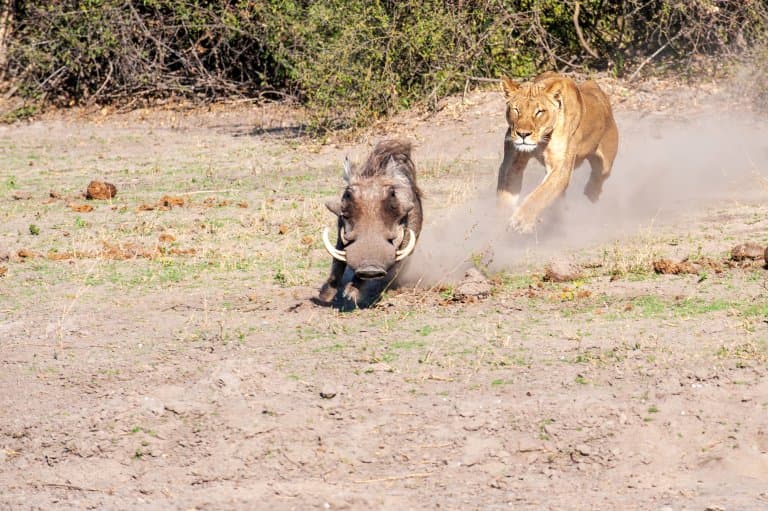
4) Warthog will ‘back into holes’ to defend themselves
Juvenile warthogs will move into the burrow headfirst, however adults usually back into their holes as to keep their head facing the open.
This helps them keep vigilant for predators where they can use their tusks in attack if necessary.
5) They fight face on
Warthogs fight in a very ritualistic way, where they try and push their opponent over.
They push, strike and box with their heads and tusks, but also use these to defend themselves too.
6) Their warts are used as a cushion
When warthogs fight, their ‘warts’ are used to help cushion the blows from their adversary. Also the larger warts help protect their eyes in combat.
In general, males have a total of three pairs of warts on their face which are larger than females which often have two. 2
7) Males like to strut
During rutting seasons, when males will look for females to mate with, they will visit many burrows and often wait for the females to emerge.
Males will then strut in their vicinity to show their dominance and sometimes rest their chins on females before mating.
8) Warthogs like order
A mother warthog likes to control and keep things in check with her piglets. When they move with intent, they will often do so in a fixed order and line, rather than a group.
A loud grunt from the mother tells the piglets to run from danger and they will run in this ordered fashion to the nearest hole.
9) They live in groups called ‘sounders’
An average group of warthogs consists of a mother and her new young and possibly two other sows with older young.
Females usually have good bonds and can stay together for multiple breeding cycles. Sub-adult males can form bachelor groups but leave these as they reach adulthood (over four years). 3
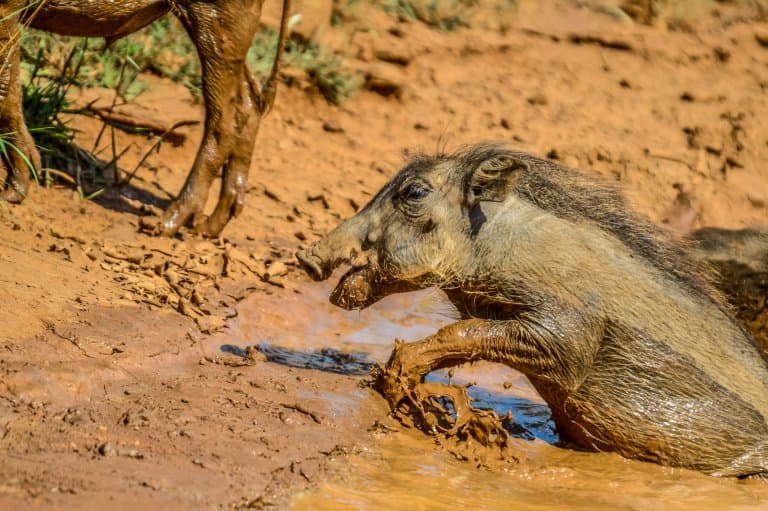
10) Warthogs like to keep tidy
Warthogs will groom each other in social groups.
They have been seen to lie in front of one another, with one using its lips and teeth to clean the mane of another. This can help strengthen connections between the group.
11) Females leave the family to give birth
When a female is about to give birth to her piglets she will leave the group she is in and go and find her own burrow or hole. She will remain here for 6-7 weeks with her young and only leave for short periods to graze (less than usual). She hardly ever leaves the burrow in the piglets first year of life.
12) Warthogs use different types of noise to communicate
After warthogs have been separated, they often make loud grunting noises when back together (and have been observed even touching noses).
Growling indicates more threatening behaviour, and if they are being defensive or submissive they will often squeal. Clacking noises are used to help entice females by males.
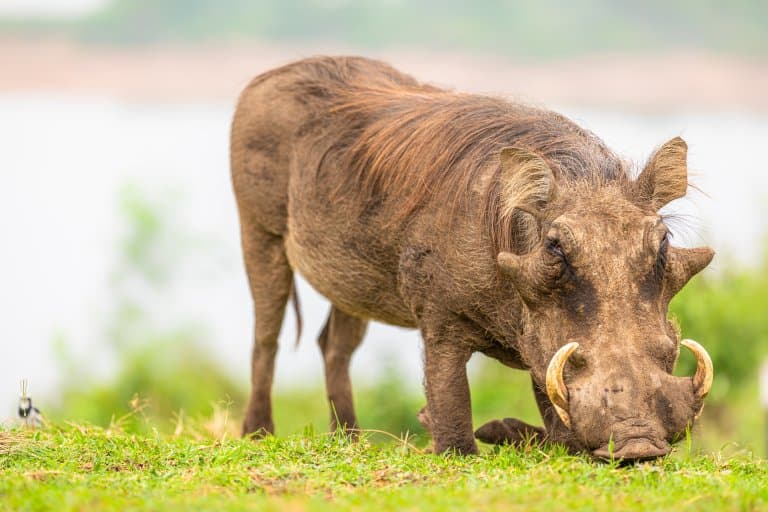
13) Both males and females show others they are near
Warthogs of both sexes like to mark objects such as trees and rocks to show others of their territory. They also like to mark each other. They do this with their tusks and also glands on their face.
Males mark more frequently and have been noted to urinate in their wallows to help spread their scent.
14) Males like to stay up longer than females
Females and piglets will go into their holes at around dusk, where males will often stay out up to two hours later before they retire for the night.
15) Piglets start grazing quickly
Young warthogs start foraging from around 2-3 weeks old and will be totally weaned by around 6 months old.
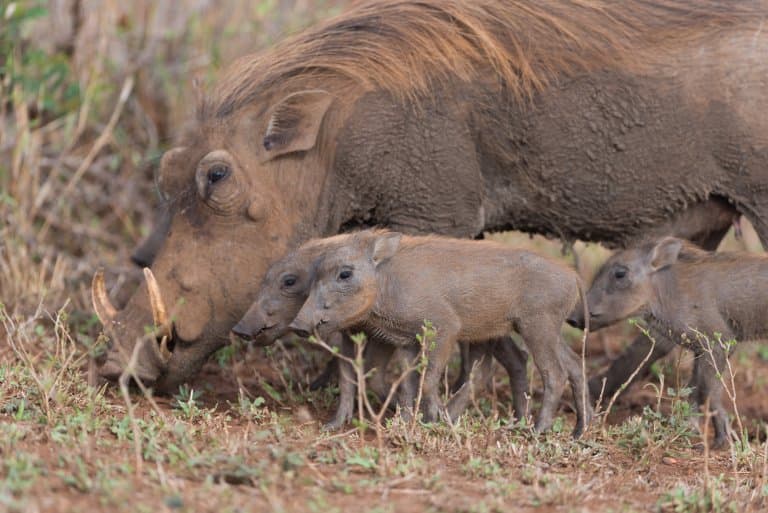
16) Their tusks are hunted for ivory
Elephant ivory is illegal, but this isn’t the case for warthogs where their tusks are still carved for the tourist trade in eastern and southern Africa.
17) Fortunately, they are ‘least concern’ in their conservation status
This is because they are highly intelligent, adaptable and have thriving populations across Africa, which is unlike so many species that are endangered. 4
Warthog Fact-File Summary
Scientific Classification
| Kingdom: | Animalia |
| Phylum: | Chordata |
| Class: | Mammalia |
| Order: | Artiodactyla |
| Family: | Suidae |
| Genus: | Phacochoerus |
| Species Names: |
Phacochoerus aethiopicus (Desert warthog) Phacochoerus africanus (Common warthog) |
Fact Sources & References
- Amy Y. Conry Davis, “10 Wild Warthog Facts“, Tree Hugger.
- “Warthog“, National Geographic.
- Richard Despard Estes (1997) “The Behavior Guide to African Mammals”, Book.
- San Diego Zoo Editorial, “Warthog“, San Diego Zoo.
